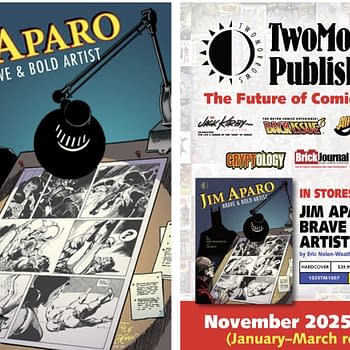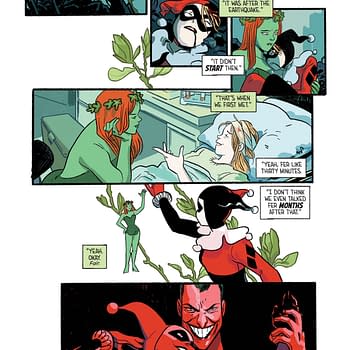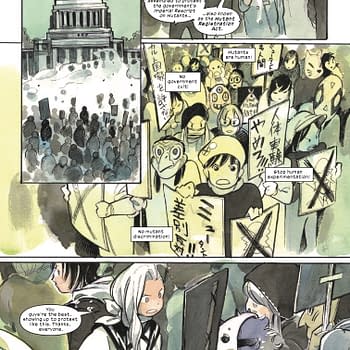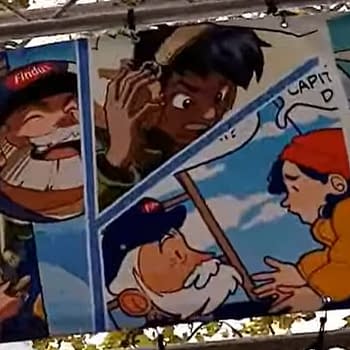Posted in: Comics, Recent Updates | Tagged: big trouble in little china, boom studios, Comics, dan slott, dynamite, entertainment, john carpenter, Kick Ass 3, Marvel Comics, miracleman, moon knight, peter milligan, superior spider-man, Terminal Hero, warren ellis
Thor's Comic Review Column – Terminal Hero, Superior Spider-Man, Moon Knight, Miracleman, Big Trouble In Little China, Kick Ass 3
This week's reviews include:
Terminal Hero #1
Superior Spider-Man #32
Moon Knight #6
Miracleman #9
Big Trouble in Little China #3
Kick-Ass 3 #8
Terminal Hero #1 ($3.99, Dynamite)
By D.S. Randlett (@dsrandlett)
I've never been the world's biggest Peter Milligan fan. Like many who count comics as a hobby, I've drifted in and out of the scene as personal funds allowed, and much of Milligan's most well known output was coming out either when I was too young to get it or when I was in my starving student days. As such, I missed out on his Shade as a young'un and his and Allred's X-Force as a college student, and thus have never gotten on the Doop train. But what I have read of his work (so, Hellblazer, basically) has always reminded me of a very specific period of Vertigo comics. Which makes sense as he, along with Neil Gaiman and Karen Berger, was a pretty instrumental figure in developing that period's voice. Terminal Hero is another strong evocation of that period's voice, but it includes many of the problems that Vertigo's "British Invasion" had, mainly a feeling of disconnect and detachment from its own narrative.
At its best, Vertigo's British Invasion brought a new sense of humanity to comics storytelling by finding new ways and forms to bring genuine and earned pathos to the stories that they were telling. At its worst, this era assumed that very same pathos from the reader and forget that the maturity of these stories came from the earning of their emotions and not their mere display. This latter phenomenon, in my opinion, would eventually come to dominate the Vertigo line, resulting in a lot of series that I often thought of as boilerplate Vertigo. Off-beat fantasy conceit? Check? Unearned emotional beats masquerading as mature storytelling? Check and check.
Terminal Hero isn't quite in the boilerplate Vertigo mold. For one, its basic conceits are far more interesting. At the core of this story is the idea of reckoning with one's own mortality, and the attempt to overcome that mortality leading into some pretty spectacular Jekyll and Hyde places. When Dr. Rory Fletcher is diagnosed with an inoperable brain tumor, a friend suggests a little-known experimental treatment. The treatment works, but then there are the side effects. Rory starts seeing things, but those things actually manifest, the avatars of his anger, hurt, and desire are all brought, quite destructively, into reality. These scenes are easily the best in the comic, and where the links between Terminal Hero's themes, genre play, and its narrative are working on all the right levels. At its best, Terminal Hero is like a horror version of Firestorm, and it's like that a lot. And it must be said, a lot of this is down to artist Piotr Kowalski giving these scenes a sense of ghostly urgency.
There's a bit about the story that doesn't quite work, however. It's clear that Rory has tragedies in his past, most notably involving his sister. A big part of the story is the unleashing of this inner darkness, but that inner darkness is never quite felt through the narrative, but merely stated. So while the book's visceral horror is often convincing in and of itself, the emotions that undergird it aren't so apparent. A lot does happen in this first issue, so a lot gets sacrificed in favor of forward momentum, which isn't a decision that I can really fault. However, the lack of depth in terms of Rory's past makes his references to it seem kind of matter of fact rather than evocative, and creates a sense of disconnect from the narrative. This doesn't cripple the story, but it does have the effect of artlessly slopping more onto an already effective emotional center. I can see why, say, the elements involving Rory's dead sister may have been necessary for the narrative in future issues, but these elements cause a slight bit of dissonance in the flow of this first issue.
Still, Terminal Hero is one of the more compelling first issues I've seen in some time. If you're looking for a capable blend of superheroes, horror, and personal drama, you could hardly do much better. Despite some speed bumps, this is a story that just works, and I'll be looking forward to seeing where it's headed.
D.S. Randlett lives in the hills of Virginia and takes credit for the reviews that his emaciated twin brother writes while chained to the old radiator. He plays his guitar while biding his time for unsuspecting tourists and thinking about going to grad school.
Superior Spider-Man #32 (Marvel, $4.99)
By Cat Taylor
Back in the 1980s, during Grant Morrison's groundbreaking run on Animal Man, he included a subplot that ran over several issues where an Animal Man doppelganger was lurking about. Who he was and his purpose remained a mystery until many issues later when Animal Man was sent back in time and it was revealed that the Animal Man "doppleganger" was actually Animal Man himself who had travelled back in time. It was an innovative approach that should have been an obvious story arc to other writers years before. After all, comic book characters are always travelling through time but to my knowledge no writer had shown the effects of that time travel before it was actually written. The concept of preparing for a future story of time travel before it happened let the reader experience the same confusion experienced by the present-day characters rather than giving the reader the standard omniscient view of knowing that the out-of-place character was an anachronism. Dan Slott and Christos Gage's story in this issue of Superior Spider-Man isn't quite as innovative but it's a pretty creative and similar approach in its own right. As you probably know, Superior Spider-Man officially ended its run a few months ago, but Slott and Gage found a moment in issue #19 where the Otto Octavius Spider-Man disappeared in an explosion for 24 hours and have used that moment to tell a new story.
In order to kick-off the upcoming Spider-Verse mega-event, Slott and Gage have temporarily resurrected the Superior Spider-Man title with issue #32 telling what happened to Octavius Spidey during that disappearance. In case the cat isn't already out of the bag, Otto Spidey spent that time in the year 2099, after swapping places with Spider-Man 2099. This event is the catalyst that is leading Otto Spidey to travel through various times and realities, gathering every version of Spider-Man that has ever been published on a comic book page. There is a plot-driven purpose in his intentions but the real purpose from Marvel's point of view is a Spider-Man mega-crossover event.
Although I do like the creative approach of using a past incident to lead into something bigger, the premise that the writers have used to create the need of a gathering of Spider-Men seems pretty flimsy so far. Undoubtedly, good writers can develop the story as it progresses and it may well end up being one of the better "big events." In fact, I admit to being pretty curious about how the different Spider-Men will interact and think the read might be a fun experience. However, the reason established here is the kind of reason that just about anyone would think of if they had a gun to their head and were told, "Give me a reason to bring every version of Spider-Man ever together to take care of a problem right now or I'll shoot you!" It's not just the concept that feels rushed either. The progression of the story itself is very fast, using only a panel or two to get each necessary moment across in a hurry to get to the end. Even the design of the villain in this issue looks like someone randomly patched a character together out of the first images he saw while flipping through television channels. "Okay, let's use a guy in colonial clothing and stick his head in an old-school diving helmet. He's going to need a weapon. So, how about a big frog gigger but like a light saber or something. Voila, we've got a villain!"
I also found the whole structure of this issue to be pretty strange. There's a complete 22 page story as usual but in order to justify adding an extra dollar to the cover price they've included a seven page back-up feature. However, the back-up feature is really just a continuation of the main story drawn in what appears to be a rush job by comics' legend, Adam Kubert. As far as I can tell, the fact that there's a different artist is the only reason the last seven pages are written as a back-up feature rather than just making them part of the main story. In case you are wondering, the rest of the issue's art is handled by the very experienced and capable Giuseppe Camuncoli and John Dell. Camuncoli and Dell are standard, run-of-the-mill talented Marvel artists who use a modern Marvel house-style that seems most inspired by John Byrne.
Overall, I like the creative approach that Slott and Gage have used to spin the upcoming Spider-event out of a past Superior Spider-Man story, and it has done its job in getting me interested in things to come. On the other hand, as a single story in a single issue of a comic book, the whole thing can best be summarized by the word, "rushed." There's no build-up. On the contrary, it seems that Marvel is in a big hurry to get this event off the ground. Hopefully, that's a sign that a lot of exciting things are about to happen in Spider-Verse.
Cat Taylor has been reading comics since the 1970s. Some of his favorite writers are Alan Moore, Neil Gaiman, Peter Bagge, and Kurt Busiek. Prior to writing about comics, Taylor performed in punk rock bands and on the outlaw professional wrestling circuit. During that time he also wrote for music and pro wrestling fanzines. In addition to writing about comics, Taylor tries to be funny by writing fast food fish sandwich reviews for Brophisticate.com. He has the dubious distinction of not having a Twitter account but you can e-mail him at cizattaylor@hotmail.com.
Fearful Symmetry: Reflections on Miracleman #9 and Moon Knight #6
By Adam X. Smith
Lo those many moons ago when we ran our first column, I exhorted you to read Moon Knight #5; in a run that so far has had me hooked from the first issue, it was the comic book equivalent of fried gold on toast, a perfect self-contained episode in a series built on them. Now, Moon Knight #6 is out.
Look, I know I'm the Warren Ellis fan-boy of the group, and that means that I'm subject to lapses in objectivity when it comes to his work. However, that being said, Moon Knight #6 takes on the unenviable task of being a fitting end to Ellis and Declan Shalvey's run and topping the brilliance of not just #5 but all the previous issues so far.
The good news is that what could have been a safe victory lap is actually a clever inversion of everything the rest of the series so far had been setting up. Building on his previous experience working on single issue storylines from the likes of Global Frequency, Ellis switches tack by taking us back to the events of the first issue, where the casual dismissal by "Mister Knight" of Ryan Trent, a beat cop with a crappy attitude, comes back to haunt him in a big way, as Trent becomes obsessed with replacing Moon Knight by becoming his nemesis Black Spectre.
I'm sad to see Ellis and Shalvey leave this book so early, but then again, that's Warren Ellis' schtick at Marvel: move in and revamp something that's underperforming (c.f. Iron Man and Thunderbolts), get people talking about it again and then pimp away to work on the next thing. Plus it's not like there aren't plenty of other Ellis books happening at the moment*, and Brian Wood and Greg Smallwood will be taking over so I guess we'll see how that shakes out.
Meanwhile…
Back in the dim and distant days of earlier this year we saw the return of Miracleman to shelves after years of being out of print, an event that was significant enough to justify us devoting a good chunk of a column to our reaction to it. As the issues wore on, however, a lot of people seemed kind of annoyed at the pace at which the story was being delivered, with many impatient to get their hands on the long-awaited lost Neil Gaiman issues that were the impetus for Marvel obtaining the rights in the first place. Sure the series was benefiting from the remastered artwork, but nine issues in eight months of a comic that's been sitting in purgatory since the early Nineties is apparently too slow for some people. Nevermind that it was basically replicating the Eclipse Comics reprints of earlier Warrior issues from the Eighties with the addition of retro Mick Anglo strips and tons of extra stuff – we want our cake now, damn it!
Well folks, this week you got your cake, and you're gonna have your faces rubbed in it. This, for those unfamiliar with Alan Moore or their comic book history, is the infamous issue in which Liz Moran, wife of Miracleman's alter ego Mick Moran, gives birth to their daughter in what can only be described as incredibly graphic detail, rendered by Rick Veitch with a skill that at once inspires awe and queasiness.
The fact that this is still a hot-button issue nearly thirty years on is testament to the fact that no-one had really done it before and have yet to equal it since. I knew it was coming and I still wasn't quite prepared for how graphic it was going to be – my fiancée TheJojo tells me we saw a few of the panels in a clip from a documentary on Youtube but I've evidently either blocked it out or I've since used that part of my brain for something less disturbing.
Of course it's not just the detail that makes it controversial – like me, I'm sure many of you have seen Alfonso Cuaron's Children of Men, where Clive Owen has to deliver a baby in a run-down tenement in the middle of a refugee camp in a dystopian future – it's more the fact that it's being shown at all. In most instances where birth is depicted on screen or in comics – even in documentaries – the fourth wall is conveniently angled away from what is going on downstairs. We aren't forced to look away because no-one is making us look in the first place; we can just look at the wincing face of the mother and put the rest together using our imaginations. Or better still ignore it entirely and think of something else.
For a comic that has not one but two content warning labels AND comes in a sealed polybag to prevent it being accidentally skimmed by young Timmy, there's not a lot of questionable content in it besides a frank depiction of the miracle of life – especially when you consider that the previous issue features a temporarily powerless Moran getting his finger bitten off and being forced to bash a dog's brains in with a rock. You'd almost think that the majority of comic book readers still weren't ready to deal with the basic facts of biology, and maybe that's true of many of us, but the fact remains that if you can't handle seeing the birth of a child with all the grotesquery it entails in the pages of a comic book, you're probably not going to fare much better with the real thing. Just a thought.
I could be wrong, I could be right.
*Whilst I have no opinion whatsoever on Ellis' Barcadi graphic novel having not read it yet or seen any of the publicity materials associated with it, I will say that whilst it is tempting to shout "sell out", I would also remind people that John Lydon did adverts for Country Life butter and Iggy Pop has done adverts for car insurance. Nothing is sacred. Tell 'em, Henry.
Adam X. Smith is a paranoid android from the Planet X. For the last 27 years he has been living amongst the people of Birmingham, England (and more recently the University of Lincoln) ostensibly as a student of the school of hard knocks (also BA Hons Drama), but secretly on a mission to scout out the planet for invasion by alien forces; his weekly communiques on his various blogs are actually highly coded messages to his extra-terrestrial masters. He enjoys the musical stylings of local chiptune-metal band Elmo Sexwhistle, the fiction of Kim Newman, Kurt Vonnegut and Chuck Palahniuk, and his hobbies and interests include film-making, drama, occasional Youtubing, journalism and plotting the subjugation of humanity. He can be found on Youtube, Tumblr, Twitter or by jamming an ice-pick through the optic chiasm.
Big Trouble in Little China #3
By Bart Bishop
Released in 1986, Big Trouble in Little China didn't exactly make waves at the box office. In the years since, however, it's become a cult film favorite and staple of many '80s childhoods, myself included. One can assume the same can be said of Eric Powell, the writer of the comic book continuation that's now three issues in. Powell, best known for his original series The Goon that mixed the macabre with gallows humor and blue-collar sensibility, would certainly seem to be the perfect fit for the new adventures of Jack Burton, as would his collaborator on the story John Carptener who wrote and directed the movie. Along with artist Brian Churilla, Powell has crafted a fun ride that certainly feels true to the spirit of the original, even if Carpenter's braggadocio score, breakneck pacing and creeping sense of dread are missed. It has a bit of a slow start, but where it really excels is in the abject weirdness that follows the perfunctory first issue, although it does trip itself up with easy cultural clichés.
The story picks up immediately where the movie left off, with Jack chugging down the highway in the Porkchop Express. Lo Pan's demon beast stowaway rears its ugly head and turns out to be bonded to whoever killed his former master, namely Jack. He heads back to Chinatown to see if Wang Chi, who is celebrating his wedding day, and Egg Shen can rid him of the beast (dubbed Pete), only for the Wing Kong gang and Lo Pan's apprentice, Qiang Wu, to crash the wedding and kidnap Wang. This sends Jack and Egg on a journey to the Hell of the Seven-Faced Widow to retrieve jars that contain the Three Storms, Thunder, Rain and Lightning. That journey encompasses the next two issues, with Jack and Egg bumbling through bizarre landscapes and uncanny opponents, with Jack's deadpan humor and a nice bit of slapstick thrown in to balance things out.
Powell does a fine job of balancing Carpenter's characters while maintaining his own style. It's a task bringing Kurt Russell's bumbling John Wayne pantomime to life and Powell succeeds but also isn't afraid to put his own stamp on Jack Burton. For instance, I always got the impression that Jack was a seasoned truck driver experiencing the supernatural for the first time, heightening the fact that he was in over his head. The comic version, however, has a long and winding history of encountering ghosts and goblins in the form of his ex-wives, which makes for nice structural consistency as Jack blissfully recounts stories that show how oblivious he is to his surroundings. I don't hate this new addition, but I prefer the Jack that's new to all this. Still, it works as an in-text justification for the series as Jack has not only been on an adventure like this before, he's always been adventuring like this. Unfortunately Egg is more there for the slapstick humor rather than as a character, and the rest of the cast at this point isn't much more than wisecracks and, in the case of Qiang Wu, mustache-twirling Yellow Peril.
Churilla is fitting for this kind of story. His style borders on comic strip cartoonish, and is reminiscent of Mike Mignola and Guy Davis's broad lines and exaggerated features. That's appropriate considering the content, as Jack finds himself in the kind of circumstances Hellboy would be comfortable in. Churilla has a nice sense of comic timing and just the right degree of caricature when it comes to the characters, but he also renders awesome sights in the truest definition of the word. The second issue has a surreal instance of a wanderer straddling the back of a giant turtle, and the hell Jack and Egg wander through is suitably Lovecraftian with its disquieting designs and maddening figures. Where Churilla struggles, however, is in how his characters can be flat and static in their movement, while backgrounds are often left blank, giving the foreground a sense of floating that could be utilized thematically but doesn't come across as intentional.
The biggest problem with the whole endeavor is the aforementioned Yellow Peril of Qiang Wu and the overall orientalism of Chinatown. This is a holdover from the movie so it's somewhat expected, and the satirical tone and bushwhacking of Burton's standard American white guy almost makes up for it, but it's unfortunate that these tropes still dominate. Qiang Wu, much like his master, is firmly in the Fu Manchu "Evil East Asian" vein, mystical and exotic and one-dimensionally insidious (although he does have a moment of levity when Burton makes a joke), preying upon western fears of the Other. The opposing side, meanwhile, is basically only Egg at this point as Wang has been sidelined. Egg, much like the movie, is physically diminutive but magically potent, and although his attitude is pointedly modern his aura and background are firmly painted with the foreign and unfamiliar. It's also troubling that both Carpenter and Powell seek to make Egg sympathetic through a sprinkling of western practices, from his civilian clothing and irreverent disposition, rather than humanizing him as a Chinese man. It's clear that, unlike Wang who is either Chinese American or a first-generation immigrant that's grown up in the United States, Egg is an ancient Chinese man that has never fully Americanized, but that rings hollow at times.
A faithful adaptation that is the best it can be for the medium, Big Trouble in Little China does keep me wanting for the visceral cinematic aspects of the movie. Still, it is worthy of the title.
Editor and teacher by day, comic book enthusiast by night, Bart has a background in journalism and is not afraid to use it. His first loves were movies and comic books, and although he grew up a Marvel Zombie he's been known to read another company or two. Married and with a kid on the way, he sure hopes this whole writing thing makes him independently wealthy someday. Bart can be reached at bishop@mcwoodpub.com.
Kick-Ass 3 #8 (Icon, $5.99)
By Jeb D.
Well, here it is… the final installment of Mark Millar's attempt at the world's most "disruptive" superhero comic series, forty-plus blood-soaked pages for your six bucks, and to call it "disappointing" would suggest an unreasonable level of expectation, so I guess that's not the right word… maybe what I really mean is that for all the blood and mayhem, all the hints at transgressive consideration of issues of gender and class, that we've had for the past twenty-some issues (including the Hit-Girl mini, with its attempts to contort the comic storyline to fit the movies), Kick-Ass 3 #8 is just pretty toothless.
This final series might read better in trade (not that I'm planning a re-read to find out), but the break following issue 7 really undercuts such effectiveness as #8 might have managed. We open with several pages of gangsters gloating over the brutality they're going to inflict on the captive Hit-Girl when she's delivered to them… but since she was rescued on page three of the previous issue, and we can see her blithely overlooking their little confab, the threat isn't exactly scary: the only question is how ludicrously large the number of corpses she's going to pile up will eventually grow. And for the remainder of the issue, the odds stack up more and more against Kick-Ass and Hit-Girl, only to have our heroes defeat them with a shrug; whatever virtues the series might have once had in showing what a "real" superhero would encounter has long since gone out the window, but the greatest loss is the sense of scale: we get police reports that this final showdown resulted in the deaths of 120 mobsters at the hands of these two kids, and while Dave gets his lumps here and there before his eventual triumph, in the end, the occasionally scary power dynamics that allowed Matthew Vaughn's film of Kick-Ass to transcend its source material are a distant memory.
Speaking of "Dave," one of the series' larger problems has always been the relatively emptiness of his character: initially, it was an interesting concept to make him a fairly "normal" kid, not a hopelessly dweeby Peter Parker type, but he never really developed beyond that, leaving the reader without much of a "hook" on the character, and I wonder if part of the problem might literally have been his name. As plenty of writers will tell you, finding just the right name can be vital to their conception of a character, but Millar awarded Kick-Ass' name, by way of a charity auction, to a gent named Dave Lizewski, and it may not be too far-fetched to suggest that this robbed the comics' Dave of some of the specificity that Millar once brought to an adolescent character like 1985's Toby Goodman.
As usual, nothing but praise for the artwork of John Romita Jr., and the thoroughgoing mayhem he brings to the action scenes, though I've never felt that the Kirby-like blockiness of his style works as well in the more domestic sequences. Kudos, too, to inker Tom Palmer, colorists Dean White and Michael Kelleher, and letterer Chris Eliopoulus: it would be hard to imagine Romita's pencils looking any better.
In the end, the finale of the Kick-Ass Verse is dispiritingly bland: for a guy that was kicked off The Authority for being more offensive than Warren Ellis, and who is continually threatening to piss off the fundamentalists with more of American Jesus, Millar's genial "everybody gets what they want" wrapup (with its coy references to his other Millarworld books), and cutesy end-credit sequence, undercuts any real bite that all of Kick-Ass' cussin' and killin' might have once had.
Jeb D. is a boring old married guy whose comics background includes attending the very first San Diego Comic-Con, being lectured on Doc Savage by Jim Steranko, and fetching an ashtray for Jack Kirby. After a quarter-century in the music biz, he pursues more sedate activities these days, and will certainly have a blog or Facebook account or some such thing one day.





















